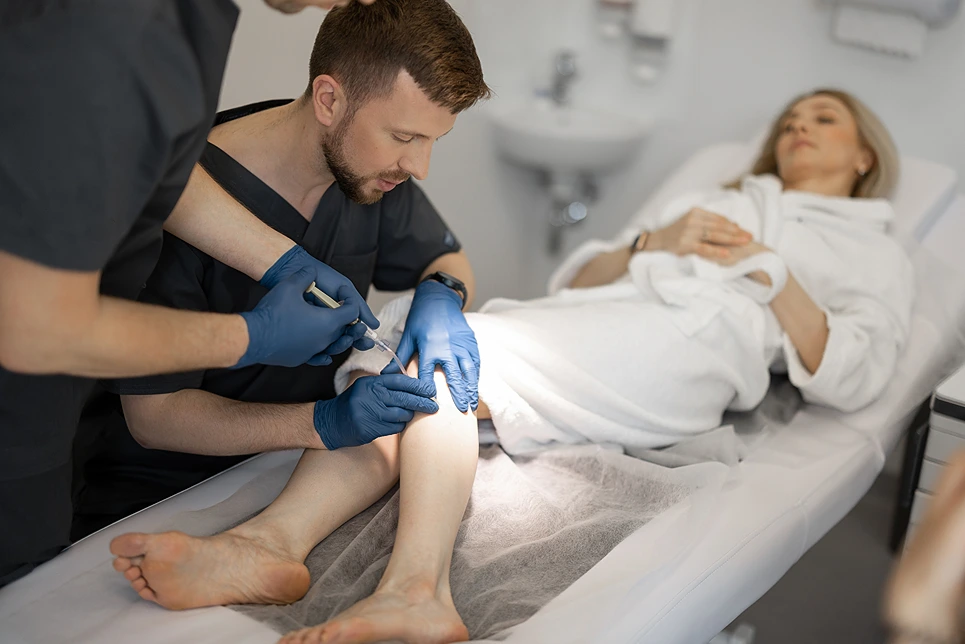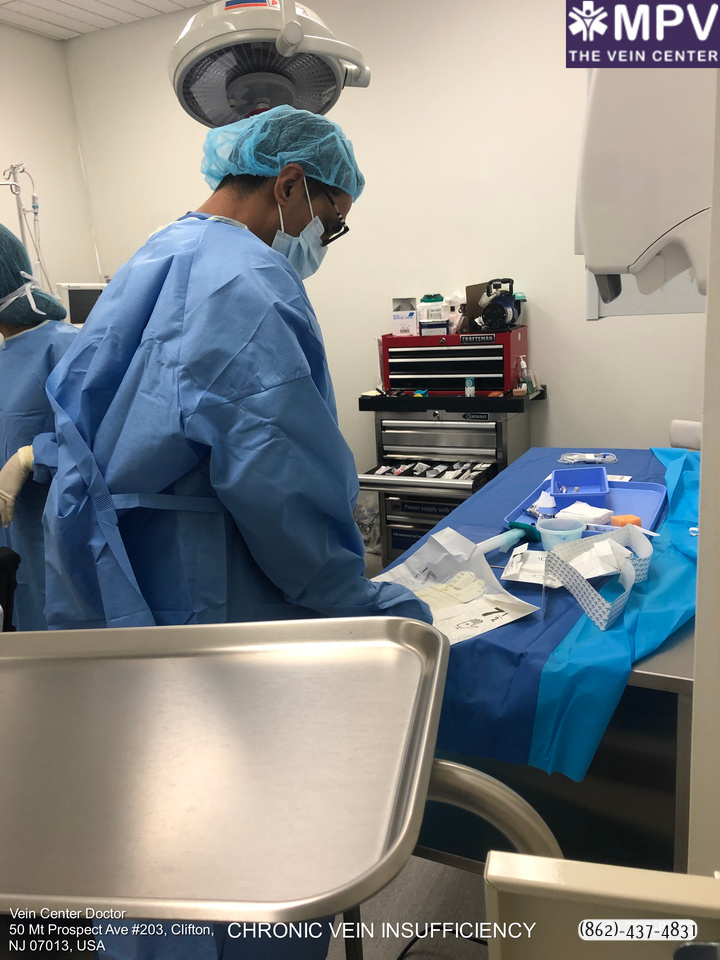Feeling the pain of heavy, achy legs that swell throughout the day? You may have chronic venous insufficiency (CVI). While symptoms may persist, today's treatments provide new hope.
Look beyond temporary pain relief - properly treat the root cause. From compression stockings to minimally invasive procedures, options exist to improve circulation and quality of life.
At The Vein Center Doctor, we stay on top of the most advanced CVI therapies. Read on as we detail progressive treatment approaches tailored to your needs - and get ready to put the spring back in your step.
Living with unwanted veins is a thing of the past, when you can simply schedule a free consultation with Vein Center Doctor and find your ideal solution today.
Chronic venous insufficiency (CVI) is a condition in which the veins in the legs are unable to efficiently transport blood back up to the heart. As described in a 2017 article by the Journal of Clinical Medicine, Maedica, this is typically caused by faulty valves inside the veins that prevent blood from flowing backward.
Blood ends up pooling in the lower extremities, leading to a variety of symptoms. At The Vein Center Doctor, we treat CVI using a combination of compression stockings, medications, minimally invasive procedures, and lifestyle changes aimed at improving circulation and reducing symptoms.
Some of our primary treatment methods include graduated compression socks to help blood flow, diuretics to reduce swelling, procedures like endovenous laser ablation to collapse damaged veins, and recommending exercise and leg elevation to our patients. While CVI cannot be cured, diligent treatment can significantly improve quality of life.
Our diagnostic process at The Vein Center Doctor begins with a medical history and physical exam to assess symptoms and check for signs of CVI. We then utilize ultrasound imaging to evaluate blood flow in the veins and identify any faulty valves or blockages. Additional tests like venous plethysmography can also measure venous pressure.
Once diagnosed, we first recommend conservative treatments like graduated compression stockings and medications like diuretics or anticoagulants. If symptoms persist, we consider minimally invasive procedures like endovenous laser ablation, radiofrequency ablation or sclerotherapy to collapse damaged veins.
In rare, severe cases where conservative treatments fail, we may recommend surgery such as vein ligation or valve repair. However, our goal is always to take the least invasive approach possible that will provide lasting relief to our patients.
While not immediately life-threatening in most cases, chronic venous insufficiency can greatly impact patients’ quality of life when left untreated. Per our experience, severe CVI cases can lead to major skin ulcerations, cellulitis infections, bleeding episodes, and recurrent thrombophlebitis.
Patients with CVI are also at increased risk for developing deep vein thrombosis. While the condition itself is not fatal, it also cannot be cured completely. However, with consistent proper treatment and lifestyle adjustments, patients can often achieve stable improvement in their symptoms and vascular health.

At The Vein Center Doctor, we grade CVI as mild, moderate, or severe based on the extent of symptoms and the presence of complications. Mild CVI produces minimal swelling and aches that can be managed with compression stockings and exercise.
Our care plans are tailored to each patient’s severity level. We educate patients on medications, compression wear use, staying active, wound care if needed, and follow-up with us for continued monitoring and treatment adjustments.
For example, a study by the National Institute for Health and Care Excellence provides guidelines on antimicrobial prescribing for leg ulcer infections, which include the use of IV antibiotics for more severe infections.
While there is currently no definitive cure for chronic venous insufficiency, the condition can often be effectively managed with diligent treatment based on our experience. The vein valve damage and dysfunction that causes CVI is a progressive, irreversible process.
However, optimizing venous circulation and blood flow with the appropriate therapies can help stabilize or slightly improve some patients’ conditions over time.
Symptoms are controlled best with a combination treatment approach of medications, compression garments, minimally invasive procedures, exercise, weight management, and leg elevation. The treatment plan must be maintained long-term as well to prevent recurrence of symptoms.
The core treatments we recommend include:
Some emerging treatments showing promise in studies include experimental drug therapies like vasoactive medications to improve circulation and growth factor injections to heal ulcers, newer minimally invasive procedures like mechanochemical ablation, external counterpulsation devices to enhance venous return, and early research on bioengineered vein valves and stem cell injections to repair damaged veins.
While still experimental, these innovations may offer less invasive future options for symptom relief. We carefully evaluate all new technologies before usage.
From our experience, there is no direct relationship between CVI and constipation. However, a study published on PubMed found that conditions increasing intra-abdominal pressure, like constipation, can trigger both lower extremity CVI and hemorrhoids.
Straining with bowel movements can also temporarily worsen CVI pressure and swelling. Additionally, some CVI medications like diuretics may contribute to constipation as a side effect, according to research from the German ESTHER cohort.
That’s why we advise patients to maintain regular soft bowel movements through a high-fiber diet and active lifestyle, based on evidence from Healthline. Proper hydration, exercise, and avoiding excessive straining can minimize CVI symptom aggravation.
In urgent situations like a leg ulcer infection or bleeding varicose vein, we advise seeking emergency care right away. Hospitalization may be required for issues like excessive blood loss, cellulitis, or extensive ulceration.
Vital medical treatments can include IV antibiotics to treat infection, debridement of necrotic tissue, multi-layer compression bandages, pain medication, leg elevation, and strict bed rest. If an underlying blood clot led to severe symptoms, anticoagulants would be administered.
Following discharge, we provide instructions on medications, compression stockings, wound care and activity modification to stabilize symptoms long-term.
Some integrative therapies may provide temporary CVI relief when used cautiously with medical treatments, but are not proven cures currently.
A 2012 Cochrane review of 17 RCTs found that oral horse chestnut seed extract appeared to improve CVI signs and symptoms compared to a placebo, though larger, definitive RCTs are still needed.
Some other naturopathic options:
The Vein Center Doctor focuses on traditional, conservative evidence-based therapies performed by vein experts as the primary approach to optimal CVI management.
Yes, certain lower body exercises can significantly help manage chronic venous insufficiency symptoms. At The Vein Center Doctor, we specifically recommend:
According to a 2016 systematic review, current evidence on the efficacy of physical exercise for CVI is limited. However, light, low-impact exercise shows promise for engaging the calf muscle pump to improve circulation.
Yes, walking is an excellent low-impact exercise for managing chronic venous insufficiency based on our experience. The calf muscle pump is activated during walking, which can aid venous return, as discussed in a study on PubMed.
We suggest starting with short, slow walks. Gradually increase distance as tolerated, use compression stockings, and take rest breaks. Monitor for skin irritation and avoid walking if blisters/abrasions develop. Check with your vein specialist about appropriate walking targets and intensity.
According to our observations, gentle massage by a properly trained therapist can temporarily reduce leg edema and heaviness in CVI patients. A study found massage increased venous blood flow in the legs.
However, effects are temporary and direct pressure over varicose veins should be avoided. Overall, massage is not a cure but may be a beneficial addition when used cautiously alongside medical treatments.
We recommend seeking out a board-certified vein specialist or phlebologist for optimal CVI treatment. Vascular surgeons are also well-trained in this area. Some other providers may oversee CVI care and provide referrals.
What’s important is to look for a physician extensively familiar with chronic venous insufficiency diagnosis and management. Our team has specialized expertise and provides complete CVI treatment.

Chronic venous insufficiency can greatly impact quality of life but implementing an appropriate, comprehensive treatment plan can significantly improve symptoms.
Partnering with a dedicated vein care specialist allows access to the latest minimally invasive procedures, prescription medications, compression garments, lifestyle changes, and ongoing monitoring to successfully manage CVI long-term.
Contact our office to learn about cutting-edge therapies that can help put you back on the path to healthy veins and legs.
Find exactly what you need to get rid of your vein-related problems. Dr. Sood and the rest of our team at Vein Center Doctor are ready to help: schedule your free consultation today.
Most Insurance is accepted for treatment